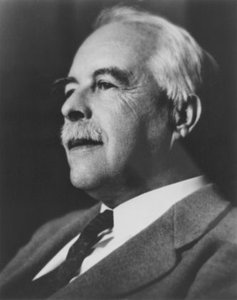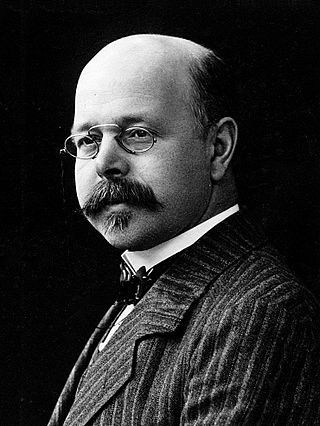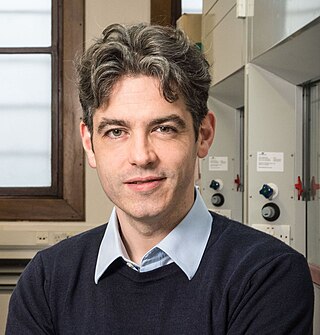Related Research Articles

Gilbert Newton Lewis was an American physical chemist and a dean of the college of chemistry at University of California, Berkeley. Lewis was best known for his discovery of the covalent bond and his concept of electron pairs; his Lewis dot structures and other contributions to valence bond theory have shaped modern theories of chemical bonding. Lewis successfully contributed to chemical thermodynamics, photochemistry, and isotope separation, and is also known for his concept of acids and bases. Lewis also researched on relativity and quantum physics, and in 1926 he coined the term "photon" for the smallest unit of radiant energy.

Walther Hermann Nernst was a German physicist and physical chemist known for his work in thermodynamics, physical chemistry, electrochemistry, and solid-state physics. His formulation of the Nernst heat theorem helped pave the way for the third law of thermodynamics, for which he won the 1920 Nobel Prize in Chemistry. He is also known for developing the Nernst equation in 1887.

Brownian motors are nanoscale or molecular machines that use chemical reactions to generate directed motion in space. The theory behind Brownian motors relies on the phenomenon of Brownian motion, random motion of particles suspended in a fluid resulting from their collision with the fast-moving molecules in the fluid.

Soft matter or soft condensed matter is a subfield of condensed matter comprising a variety of physical systems that are deformed or structurally altered by thermal or mechanical stress of the magnitude of thermal fluctuations. These materials share an important common feature in that predominant physical behaviors occur at an energy scale comparable with room temperature thermal energy, and that entropy is considered the dominant factor. At these temperatures, quantum aspects are generally unimportant. Soft materials include liquids, colloids, polymers, foams, gels, granular materials, liquid crystals, flesh, and a number of biomaterials. When soft materials interact favorably with surfaces, they become squashed without an external compressive force. Pierre-Gilles de Gennes, who has been called the "founding father of soft matter," received the Nobel Prize in Physics in 1991 for discovering that methods developed for studying order phenomena in simple systems can be generalized to the more complex cases found in soft matter, in particular, to the behaviors of liquid crystals and polymers.

Electrohydrodynamics (EHD), also known as electro-fluid-dynamics (EFD) or electrokinetics, is the study of the dynamics of electrically charged fluids. It is the study of the motions of ionized particles or molecules and their interactions with electric fields and the surrounding fluid. The term may be considered to be synonymous with the rather elaborate electrostrictive hydrodynamics. ESHD covers the following types of particle and fluid transport mechanisms: electrophoresis, electrokinesis, dielectrophoresis, electro-osmosis, and electrorotation. In general, the phenomena relate to the direct conversion of electrical energy into kinetic energy, and vice versa.

Armand Paul Alivisatos is an American etymologist, chemist and academic administrator who has served as the 14th president of the University of Chicago since September 2021. He is a pioneer in nanomaterials development and an authority on the fabrication of nanocrystals and their use in biomedical and renewable energy applications. He was ranked fifth among the world's top 100 chemists for the period 2000–2010 in the list released by Thomson Reuters.

Leroy "Lee" CroninFRSE FRSC is the Regius Chair of Chemistry in the School of Chemistry at the University of Glasgow. He was elected to the Fellowship of the Royal Society of Edinburgh, the Royal Society of Chemistry, and appointed to the Regius Chair of Chemistry in 2013. He was previously the Gardiner Chair, appointed April 2009.

Nanofluidics is the study of the behavior, manipulation, and control of fluids that are confined to structures of nanometer characteristic dimensions. Fluids confined in these structures exhibit physical behaviors not observed in larger structures, such as those of micrometer dimensions and above, because the characteristic physical scaling lengths of the fluid, very closely coincide with the dimensions of the nanostructure itself.
The Corday–Morgan Medal and Prize is awarded by the Royal Society of Chemistry for the most meritorious contributions to experimental chemistry, including computer simulation. The prize was established by chemist Gilbert Morgan, who named it after his father Thomas Morgan and his mother Mary-Louise Corday. From the award's inception in 1949 until 1980 it was awarded by the Chemical Society. Up to three prizes are awarded annually.

Molecular propeller is a molecule that can propel fluids when rotated, due to its special shape that is designed in analogy to macroscopic propellers: it has several molecular-scale blades attached at a certain pitch angle around the circumference of a shaft, aligned along the rotational axis.

Polly Louise Arnold is director of the chemical sciences division at Lawrence Berkeley National Laboratory and professor of chemistry at the University of California, Berkeley. She previously held the Crum Brown chair in the School of Chemistry, University of Edinburgh from 2007 to 2019 and an Engineering and Physical Sciences Research Council (EPSRC) career fellowship.
Jochen Küpper FRSC is a German chemist and physicist, group leader at the Center for Free-Electron Laser Science, Deutsches Elektronen-Synchrotron DESY, and Professor of Physics and Professor by courtesy of Chemistry at the University of Hamburg, Germany.
Véronique Gouverneur is the Waynflete Professor of Chemistry at Magdalen College at the University of Oxford in the United Kingdom. Prior to the Waynflete professorship, she held a tutorial fellowship at Merton College, Oxford. Her research on fluorine chemistry has received many professional and scholarly awards.
David Parker is an English chemist, Chair Professor at Hong Kong Baptist University, and Emeritus Professor at the University of Durham.

Martin Quack is a German physical chemist and spectroscopist; he is a professor at ETH Zürich.

Andrew James deMello is a British chemist and Professor of Biochemical Engineering at ETH Zürich.

Timothy Peter Softley is Pro-vice-chancellor (PVC) for research and knowledge transfer at the University of Birmingham.
Helen H. Fielding is a Professor of physical chemistry at University College London (UCL). She focuses on ultrafast transient spectroscopy of protein chromophores and molecules. She was the first woman to win the Royal Society of Chemistry (RSC) Harrison-Meldola Memorial Prize (1996) and Marlow Award (2001).
Uri Banin is an Israeli nanotechnologist and physical chemist and a professor at the Hebrew University of Jerusalem, currently holding the Alfred & Erica Larisch Memorial Chair at the Institute of Chemistry. He is recognized as one of the pioneers of nanoscience in Israel.
Michelle Dong Wang is a Chinese-American physicist who is the James Gilbert White Distinguished Professor of the Physical Sciences at Cornell University. She is an Investigator of the Howard Hughes Medical Institute. Her research considers biomolecular motors and single molecule optical trapping techniques. She was appointed Fellow of the American Physical Society in 2009.
References
- ↑ "Talk Krishnan 07 - ICPWiki". www2.icp.uni-stuttgart.de. Retrieved 24 June 2020.
- ↑ "Madhavi Krishnan / Assistant Professor of Physical Chemistry". www.flow17conference.com. Retrieved 24 June 2020.
- ↑ "Prof. Dr. Madhavi Krishnan - AcademiaNet". www.academia-net.org. Retrieved 24 June 2020.
- ↑ "Madhavi Krishnan - Research Guides". research.chem.ox.ac.uk. Retrieved 24 June 2020.
- ↑ "Professor Madhavi Krishnan". www.merton.ox.ac.uk. Retrieved 24 June 2020.
- 1 2 3 4 "Assistant professor Madhavi Krishnan receives ERC Consolidator Grant". www.mnf.uzh.ch. Retrieved 24 June 2020.
- ↑ "Recognition of Distinction" (PDF). University of Oxford Gazette. 154 (5397): 60–61. 12 October 2023. Retrieved 13 May 2024.
- ↑ "Nernst-Haber-Bodensteinpreis 2016". www.chem.uzh.ch. Retrieved 24 June 2020.
- ↑ "Professor Madhavi Krishnan | Corday-Morgan Prize winner 2020". Royal Society of Chemistry. Retrieved 24 June 2020.